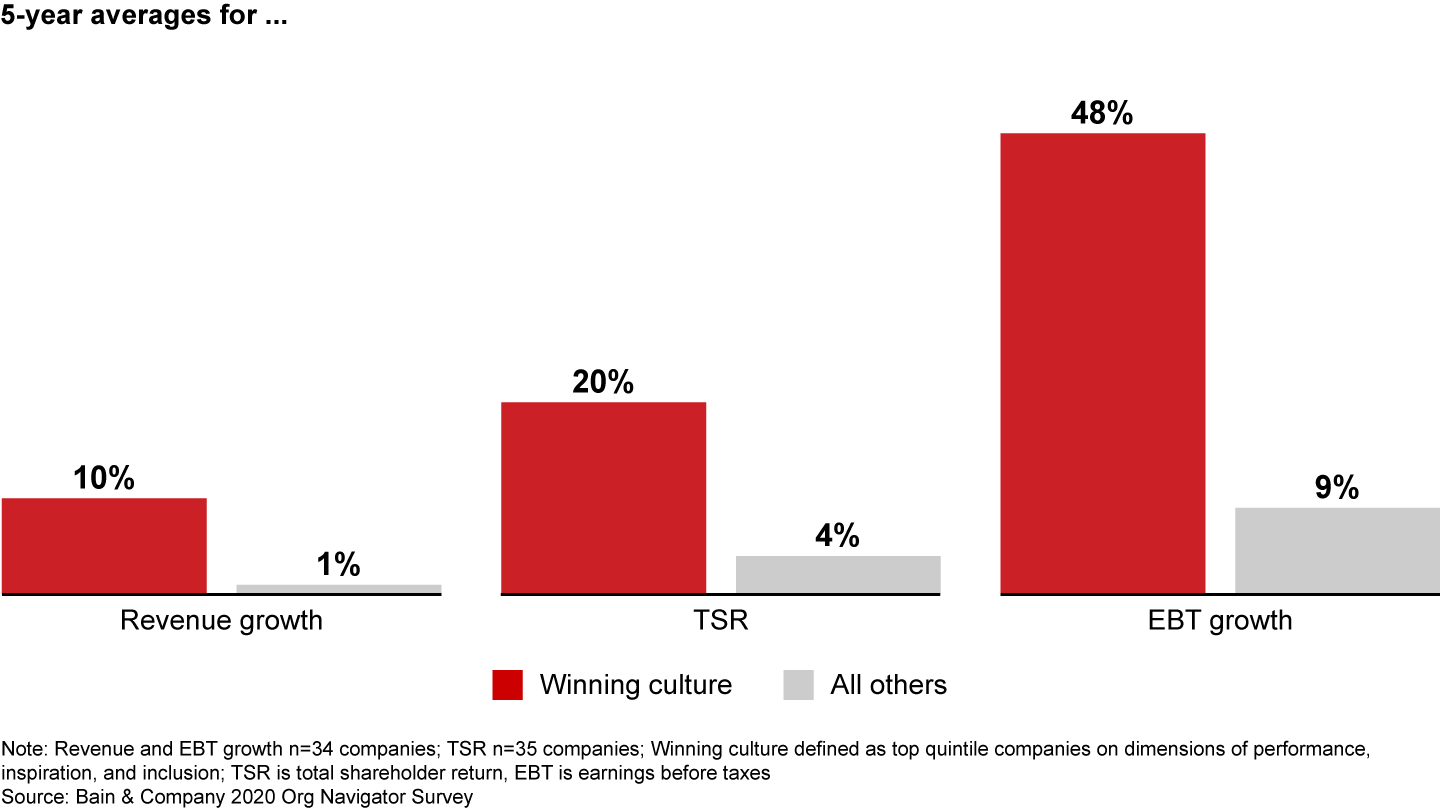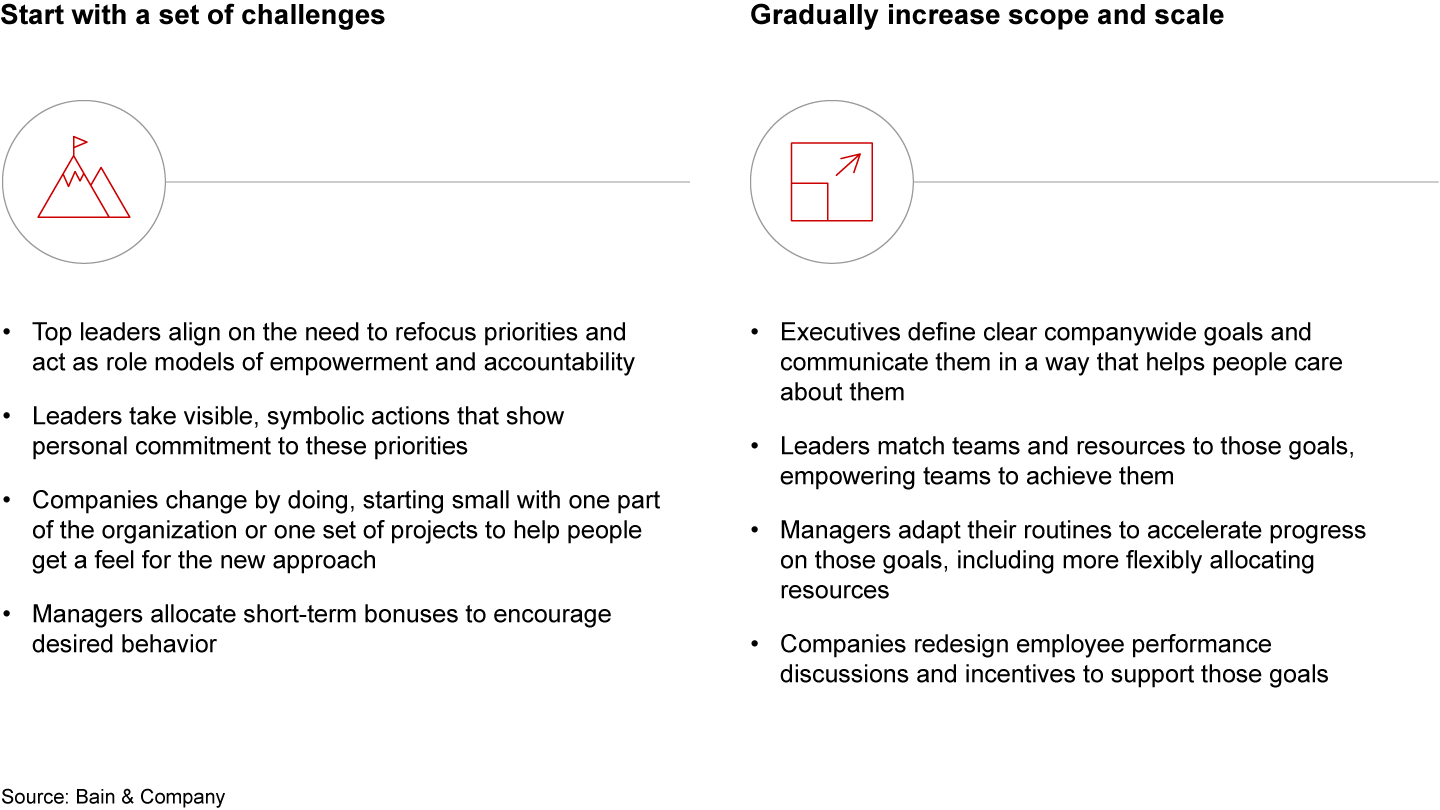Brief

At a Glance
- In high-performance organizations people are empowered, receive the right resources, and have accountability.
- A high-performance culture energizes and motivates employees.
- Over time, companies with high performance, inspiration, and inclusion generate measurably better business results.
A common question from CEOs, in both up cycles and down, is how to create a high-performance culture. It’s most often raised when a company’s strategy is clear but its metabolic rate of execution feels low. Executives, searching for an explanation, begin to consider culture and what they can do to create one that supports high performance.
In high-performance organizations, people are empowered to make decisions. They are given the resources to get things done. And they are held accountable for delivering results. A high-performance culture energizes and motivates, with a sense of both striving and safety—safety to learn, to make mistakes, and to tackle challenges that are new, big, and complex.
Historically, such a culture could develop organically as people spent time together in the office. Today’s more distributed work patterns require different ways of building a culture. It’s a puzzle well worth solving, however. When combined with high levels of leadership inspiration and inclusion, this high-performance culture becomes a winning culture that produces extraordinary long-term results. Companies that develop a winning culture generate ten times the revenue growth of companies without all three dimensions, five times the total shareholder return (TSR), and five times the growth in earnings before taxes (EBT), Bain research has found (see Figure 1).

A high-performance culture is built by taking several critical steps:
- Leaders of companies with a high-performance culture identify the outcomes—the results or changes in business performance—that their organization needs.
- They build teams tailored to take on the missions that will collectively achieve those outcomes, selecting team members for their functional expertise and also for capabilities such as digital marketing experience or data science expertise.
- These multifunctional teams are empowered to think creatively about the best way to achieve their mission, a level of autonomy well suited to the complex challenges and opportunities of business today, such as climate change or generative AI.
- Leaders clear roadblocks that can get in a team’s way, allocating financial and other resources as needed. Teams are held accountable for achieving their missions and compensated for doing so.
As a high-performance culture grows stronger, employees naturally enjoy an increasing sense of accomplishment, but maintaining a high-performance culture is a long-term commitment. India’s Reliance Industries, a conglomerate spanning telecommunication, energy, and retail with revenue of more than $118 billion, has a strong focus on results and leaders who model ambition and make decisions quickly. Teams are accountable and results oriented, and individual performance rewards are given based on achievement.
But with huge ambitions, including 5G-access for all of India, company executives realize the importance of continuing to improve Reliance Industries’ culture and have focused on a model of distributed responsibility. With this approach, a broader base of employees can contribute to improving profits and/or reducing losses, thereby building their sense of team-level accomplishment.
How to build a performance culture
Changing culture can feel overwhelming. A performance culture is built gradually, first focusing on a single set of challenges and then, over time, applying those lessons to larger projects and a broader scope of work, eventually scaling to the rest of the organization (see Figure 2). By starting in a targeted way, applying energy to a specific business issue, for example, or a certain part of the organization, companies can capture lessons from that experience and use successes to broadly generate credibility and build momentum and performance. [For more, please read “Fruitful Experiments in the Culture Lab.”]

Leaders serve as role models of accountability and empowerment. They build energy in the organization by taking steps that telegraph a clear break with tradition. A CEO seeking to enhance customer centricity could begin each monthly sales review not with a rundown of the latest figures but instead with 5 to 10 minutes discussing the question, “What did we learn from clients this month?”
In companies with a history of command and control, business review meetings can be stressful, focused on identifying problems and who is at fault. Companies with a high-performance culture take a different approach, investigating what the numbers reveal about the things that need to happen to improve results. As companies evolve toward a high-performance culture with a learning orientation, people begin to feel they can succeed and do so together. Excitement develops. But it’s important to recognize that creating a high-performance culture is progressive but not linear. As cultural changes roll out, there may be times of acceleration and times of slower progress.
A consumer packaged goods company, a former market leader, had suffered a steady decline of revenue and operating profit in parallel with the emergence of a risk-adverse, complacent culture. As part of their efforts to reignite a high-performance culture, executives realized they needed to reinvent their business performance reviews—for products, categories of products, and in some cases markets.
While the old business reviews had become risk-averse and backward-looking, focused on positive stories, even in cases where there may have been underlying issues, today presenters use the time to ask for help with difficult challenges and focus on the things that matter for the future. This is part of a cultural shift toward a “red is good” mindset in which teams discuss problems, consider the resources they need to solve them, and make quick decisions. Leaders check in periodically to see if teams are displaying this mindset. In time, the new behaviors exhibited during business performance reviews are trickling out to other meetings, permeating and changing the culture and improving results.
To ensure individuals and teams continue to focus on strategic goals, the company is reframing individual performance discussions across the organization. Whereas before the “nice” culture left managers reluctant to give honest feedback and mediocrity became accepted, today supervisors have been trained to be straightforward. The new philosophy is that a tough conversation reflects a commitment to the employee, a desire to help them improve.
Holding people to account for their work is only fair if you have also empowered them to make decisions and given them the tools, resources, and leadership support they need. When they succeed, they should be differentially rewarded based on that success in ways that support continued growth and experimentation.
Inspiration and inclusion
For a high-performance organization to maintain its momentum, executives need to ensure its people are invested in its success. This is done best with a combination of inspirational leadership and the cultivation of an inclusive culture in which people can see the importance of their personal contribution. A high-performance culture focuses on testing, learning, applying, and adjusting. High-performance organizations are willing to try new things, and sometimes fail, creating a sense of safety that can super-charge performance.

